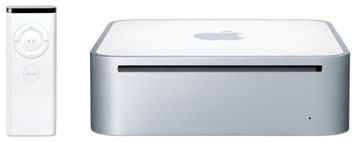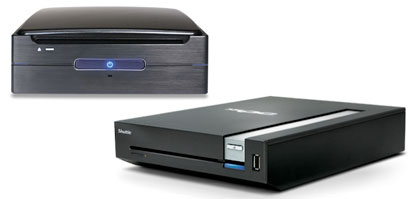Hosted by site sponsor WebMate.
Intel Mac mini Q&A - Revised August 10, 2007
To be notified of new Q&As, sign up for EveryMac.com's bimonthly email list.
How does the Intel-based Mac mini "Core Solo/Core Duo" compare to a similar Windows PC?
Please note that all systems mentioned in this Q&A have been discontinued. The Mac mini "Core Solo/Core Duo" models were replaced by the "Mid-2007" Mac mini "Core 2 Duo" line on August 7, 2007.
First, for readers who are not already familiar with the details, it may be helpful to review the specifications of the Mac mini "Core Solo/Core Duo". Apple's Intel-based Mac mini "Core Solo/Core Duo" models have a 1.5 GHz Intel Core Solo, 1.66 GHz Core Duo, or 1.83 GHz Core Duo processor, and all have a 2 MB on-chip level 2 cache, a 667 MHz frontside bus, 512 MB of 667 MHz DDR2 SDRAM (PC2-5300), an "Intel GMA950 graphics processor with 64 MB of DDR2 SDRAM shared with main memory", and an Apple Remote for use with Apple Front Row media organization software.
Connectivity of each system includes DVI (DVI-to-VGA adapter included), Firewire "400", four USB 2.0 ports, combined "optical digital audio input/audio line in" and combined "optical digital audio output/headphone" minijacks, a 10/100/1000Base-T Gigabit Ethernet port, and built-in AirPort Extreme (802.11g) and Bluetooth 2.0+EDR. The systems lack an internal 56k modem, but an external Apple USB Modem can be purchased for US$49.
The original Mac mini "Core Solo" 1.5 was configured with a 5400 RPM, 60 GB Serial ATA hard drive and a slot-loading 8X/24X/16X/24X DVD/CD-RW Combo Drive for US$599. The original Mac mini "Core Duo" 1.66 shipped with a 5400 RPM, 80 GB Serial ATA hard drive and a slot-loading 2.4X DVD±RW/CD-RW SuperDrive and cost US$799. The revised Mac mini "Core Duo" 1.66, shipped from September 6, 2006 to August 7, 2007, has the same configuration and price as the Core Solo model, but has a Core Duo processor, and the high-end model shipped during the same time period, the Mac mini "Core Duo" 1.83, has the same configuration and price as the original Core Duo 1.66 model, but with a faster processor. Another Q&A is available with all the details.

Photo Credit: Apple Computer
Like the Mac mini G4 models before it, the internal components are cleverly enclosed in a tiny and elegant 2.9 lb, 6.5 inch square, two inch tall case.

Photo Credit: AOpen (Left) & Shuttle (Right)
Although there are others as well, two "mini" Windows systems include the AOpen MiniPC MP945/MP945-V (pictured on the left) and the Shuttle XPC mini X100 (on the right). It seems doubtful that many would prefer the appearance of either over the Mac mini, but the specifications and system designs are similar.

Photo Credit: AOpen (Left Top) & Shuttle (Right Bottom)
Prior to actually shipping either system, both companies announced updated versions that have little changed internally, but use darker colored, and arguably more attractive, cases.
AOpen MiniPC
The original AOpen MiniPC MP945/MP945-V was introduced March 6, 2006, and the revised MiniPC MP945-VX/MP945-VXR on May 30, 2006. On August 29, 2006, AOpen updated the firmware to support the Core 2 Duo processor.
The MiniPC features a case design of almost identical size to the Mac mini and is based on the Intel 945GM Express chipset, the same one Apple uses. Likewise, the MiniPC has the same 667 MHz frontside bus, 667 MHz DDR2 SDRAM (PC2-5300) RAM support, and Intel GMA950 integrated graphics processor. On the original and revised specifications pages for the system, AOpen doesn't specify processor speed, just that it has a "Socket M 479" that can support a Core Solo, Core Duo, or Core 2 Duo processor. The amount of RAM also isn't specified, but the system only has one RAM slot, compared to two in the Intel Mac mini, and accordingly only can support a maximum of 1 GB of RAM. This could be a substantial drawback given the integrated graphics. The "VXR" version comes with a remote, and the "VX" version does not.
Ports, as first documented by Mini-ITX, and subsequently documented by AOpen as well, include DVI out, S-video out, a Firewire "400" port, two external USB 2.0 ports (two fewer than the Mac mini), as well as one USB 2.0 port onboard, three 3.5" audio jacks (rather than the optical jacks provided with the Mac mini), a 10/100/1000Base-T Gigabit Ethernet port, and 802.11b/g wireless (which Apple calls AirPort Extreme) occupying a mini-PCI slot. Bluetooth 2.0+EDR is not provided according to the AOpen website, but DailyTech [no longer online] notes that the mini-PCI slot "will support a Wi-Fi adaptor or a combination Wi-Fi adaptor with Bluetooth support." The Intel Mac mini systems also can support S-video with a US$19 DVI-to-Video adapter, although having both DVI and S-video ports allows the MiniPC to support a DVI display and a television at the same time. Like the Mac mini models, the MiniPC lacks a 56k modem.
Hard drive size and optical drive, along with the processor speed and RAM, are not specified by AOpen, and DailyTech mentions that "the majority of [the] MiniPCs sold in the US will ship as barebones systems [buyers are expected to add a processor, RAM, hard drive, and optical drive of their choosing], but there are plans to build fully furnished systems in Taiwan for a little under US$1000." On May 30, 2006, RegHardware reported that a "fully configured" MP945-VXR with a Core Duo processor would "start at" US$955 and on October 4, 2006 the "bare bones" configuration (no processor, drive, or RAM) was available for US$375.95.
Shuttle XPC mini
On March 2, 2006, Shuttle announced the XPC mini X100, but the press release provided little information, requiring one to dig through information provided by Mini-ITX, MacWorld, and Hexus.net to get a general idea of the specifications. After many months, Shuttle finally provided detailed specs and the system became available for purchase.
The Shuttle XPC mini X100 is 2.13 inches tall, 8.27 inches wide and 11.77 deep, larger than the Mac mini and AOpen MiniPC, but still small. It is based on the Intel 945PM Express chipset, and can be configured with a 1.83 GHz Core Duo processor, a 667 MHz frontside bus, 512 MB of dual-channel 667 MHz DDR2 SDRAM (PC2-5300), an 80 GB 3.5" Serial ATA2 hard drive. The XPC mini X100 has a slot-loading DVD-ROM/CD-RW "Combo" drive for US$1027 (it can be configured for as little as US$749). There are two RAM slots like the Intel Mac mini.
Unlike the Intel Mac mini and MiniPC, the XPC mini X100 has an ATI Mobility Radeon X1400 graphics processor with 128 MB of VRAM on an upgradable MXM module, a substantial improvement compared to the non-upgradable "integrated graphics" in the other systems. A remote is an optional purchase.
Ports include a DVI port, optical S/PDIF output (but lacks the optical input provided by the Mac mini), S-video output, three 3.5 mm audio jacks, Firewire "400", five USB 2.0 ports (four on the back and one on the front), a 10/100/1000Base-T Gigabit Ethernet port, and 802.11b/g wireless. The front also includes a 4-in-1 card reader that supports "SD, MMC, MS and MS-pro" cards. Bluetooth 2.0+EDR does not appear to be supported. Just like the Mac mini and MiniPC, the XPC mini X100 lacks an internal 56k modem (but an external USB modem can be added for US$53).
Conclusion
Each of the PC systems have some advantages over the Mac mini "Core Solo/Core Duo" systems. In particular, the S-video port, mini-PCI slot, and configuration options for the MiniPC and faster logicboard design, S-video port, superior upgradable graphics, and more configuration options for the XPC mini X100. However, each of the PC systems have some disadvantages as well -- fewer USB ports, smaller maximum RAM capacity, lack of onboard 802.11b/g and Bluetooth, and higher configured price for the MiniPC and lack of Bluetooth and higher price for the XPC mini X100.
For those who would have expected a Windows "mini" PC to cost less, this comparison should be eye-opening. No doubt most would expect the Apple systems to be sleeker, but they are more affordable as well.
Of course, in addition to besting the PC clones on price, the Intel Mac mini systems also are the only ones that Apple supports running MacOS X, and the value of the operating system should not be discounted.
Permalink | Report an Error/Typo | Sign Up for Site Update Notices
Established in 1996, EveryMac.com has been created by experts with decades of experience with Apple hardware. EveryMac.com includes, and always has included, original research incorporating detailed, hands-on inspection of packaging, computers, and devices as well as extensive real-world use. All information is provided in good faith, but no website or person is perfect. Accordingly, EveryMac.com is provided "as is" without warranty of any kind whatsoever. EveryMac.com, and the authors thereof, shall not be held responsible or liable, under any circumstances, for any damages resulting from the use or inability to use the information within. For complete disclaimer and copyright information please read and understand the Terms of Use and the Privacy Policy before using EveryMac.com. Copying, scraping, or use of any content without expressed permission is not allowed, although links to any page are welcomed and appreciated.
